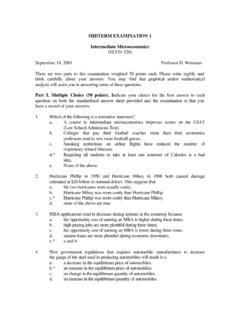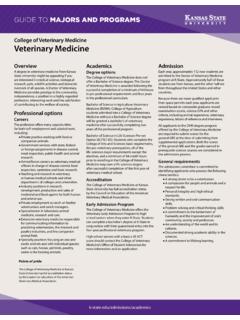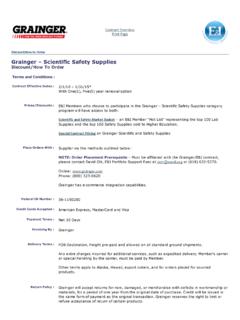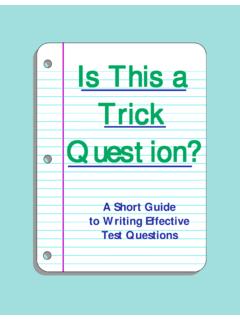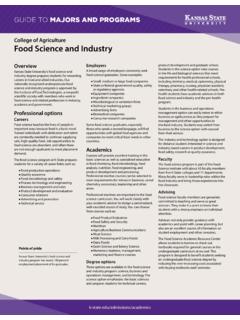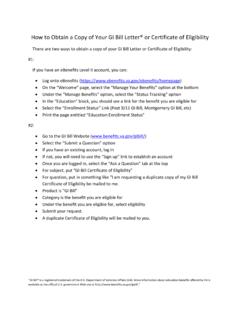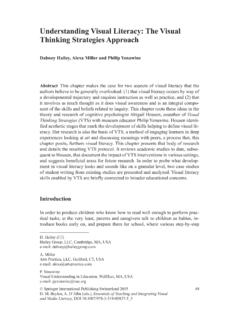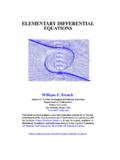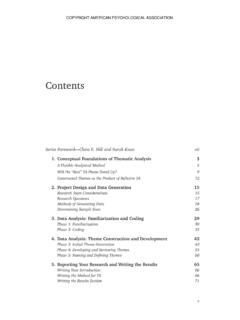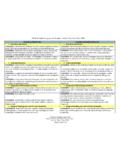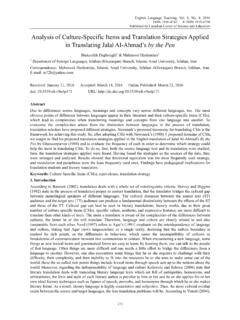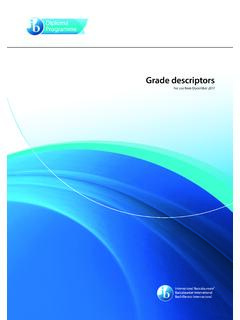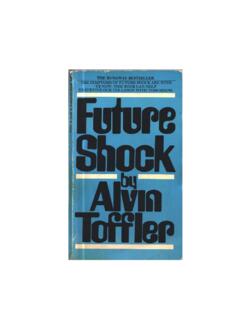Transcription of Paper #1: Comparative Analysis - Kansas State University
1 ENGL 680 Realism and Sentimentalism in American Literature | Gregory Eiselein | Fall 2007 Paper #1: Comparative AnalysisBasic Assignment. Choose two of the first four texts on our semester's schedule and write a four-to-six page Paper that compares the two works of and Advice. You might compare the two realists (or the two sentimentalists) who takedifferent approaches within the same genre. Or you might compare the styles or aims of authorswho seem to be working in much different genres, comparing a realist to a sentimentalist. Youcould compare two writers by detailing an important relationship between them, a relationshipsuch as influence or antagonism. Or you could compare literary techniques or political aims orthemes and so on.
2 How do the two authors deal with gender or treat issues of democracy andclass? How does each work appeal to the emotions or our sense of reality or whatever. In short,you may compare realism to sentimentalism or compare two different kinds of realism orcompare two different approaches to are many different ways to approach a Comparative Analysis , though I think it is key tofigure out what your grounds for comparison are (why did you pick these two texts rather thansome other texts ?) and your reasons for comparing (why bother? or what is interesting,significant, or productive about comparing these two texts ? what do we learn about thesetexts that we might not realize by justreading them separately when wecompare them to each other?)
3 For more specific advice, I haveattached to this sheet Kerry Walk'shandout on "How to Write aComparative Analysis ." For most ofyou, this may be review. On the otherhand, if you've never written a paperlike this, you will find her The Paper should have agood title. It should be typed anddouble-spaced. Please use MLA styleto cite texts and provide information onyour Date. Wednesday, October 4-6 : Richard Wright2 How to Write a Comparative AnalysisThroughout your academic career, you'll be asked to write papers in which you compare and contrast twothings: two texts , two theories, two historical figures, two scientific processes, and so on. "Classic"compare-and-contrast papers, in which you weight A and B equally, may be about two similar things thathave crucial differences (two pesticides with different effects on the environment) or two similar thingsthat have crucial differences, yet turn out to have surprising commonalities (two politicians with vastlydifferent world views who voice unexpectedly similar perspectives on sexual harassment).
4 In the "lens" (or "keyhole") comparison, in which you weight A less heavily than B, you use A as a lensthrough which to view B. Just as looking through a pair of glasses changes the way you see an object,using A as a framework for understanding B changes the way you see B. Lens comparisons are useful forilluminating, critiquing, or challenging the stability of a thing that, before the Analysis , seemed perfectlyunderstood. Often, lens comparisons take time into account: earlier texts , events, or historical figures mayilluminate later ones, and vice with a daunting list of seemingly unrelated similarities and differences, you may feel confusedabout how to construct a Paper that isn't just a mechanical exercise in which you first State all the featuresthat A and B have in common, and then State all the ways in which A and B are different.
5 Predictably, thethesis of such a Paper is usually an assertion that A and B are very similar yet not so similar after all. Towrite a good compare-and-contrast Paper , you must take your raw data the similarities and differencesyou've observed and make them cohere into a meaningful argument. Here are the five of Reference. This is the context within which you place the two things you plan to compare andcontrast; it is the umbrella under which you have grouped them. The frame of reference may consist of anidea, theme, question, problem, or theory; a group of similar things from which you extract two forspecial attention; biographical or historical information. The best frames of reference are constructed fromspecific sources rather than your own thoughts or observations.
6 Thus, in a Paper comparing how twowriters redefine social norms of masculinity, you would be better off quoting a sociologist on the topic ofmasculinity than spinning out potentially banal-sounding theories of your own. Most assignments tell youexactly what the frame of reference should be, and most courses supply sources for constructing it. If youencounter an assignment that fails to provide a frame of reference, you must come up with one on yourown. A Paper without such a context would have no angle on the material, no focus or frame for the writerto propose a meaningful for Comparison. Let's say you're writing a Paper on global food distribution, and you'vechosen to compare apples and oranges.
7 Why these particular fruits? Why not pears and bananas? Therationale behind your choice, the grounds for comparison, lets your reader know why your choice isdeliberate and meaningful, not random. For instance, in a Paper asking how the "discourse of domesticity"has been used in the abortion debate, the grounds for comparison are obvious; the issue has twoconflicting sides, pro-choice and pro-life. In a Paper comparing the effects of acid rain on two forest sites,your choice of sites is less obvious. A Paper focusing on similarly aged forest stands in Maine and theCatskills will be set up differently from one comparing a new forest stand in the White Mountains with anold forest in the same region.
8 You need to indicate the reasoning behind your The grounds for comparison anticipates the Comparative nature of your thesis. As in anyargumentative Paper , your thesis statement will convey the gist of your argument, which necessarilyfollows from your frame of reference. But in a compare-and-contrast, the thesis depends on how the twothings you've chosen to compare actually relate to one another. Do they extend, corroborate, complicate,contradict, correct, or debate one another? In the most common compare-and-contrast Paper one3focusing on differences you can indicate the precise relationship between A and B by using the word"whereas" in your thesis:Whereas Camus perceives ideology as secondary to the need to address a specific historicalmoment of colonialism, Fanon perceives a revolutionary ideology as the impetus to reshapeAlgeria's history in a direction toward your Paper focuses primarily on difference or similarity, you need to make the relationshipbetween A and B clear in your thesis.
9 This relationship is at the heart of any compare-and-contrast Scheme. Your introduction will include your frame of reference, grounds forcomparison, and thesis. There are two basic ways to organize the body of your Paper . In text-by-text, you discuss all of A, then all of B. In point-by-point, you alternate points about A with comparable points about you think that B extends A, you'll probably use a text-by-text scheme; if you see A and B engaged indebate, a point-by-point scheme will draw attention to the conflict. Be aware, however, that the point-by-point scheme can come off as a ping-pong game. You can avoid this effect by grouping more than onepoint together, thereby cutting down on the number of times you alternate from A to B.
10 But no matterwhich organizational scheme you choose, you need not give equal time to similarities and differences. Infact, your Paper will be more interesting if you get to the heart of your argument as quickly as , a Paper on two evolutionary theorists' different interpretations of specific archaeological findingsmight have as few as two or three sentences in the introduction on similarities and at most a paragraph ortwo to set up the contrast between the theorists' positions. The rest of the Paper , whether organized text-by-text or point-by-point, will treat the two theorists' can organize a classic compare-and-contrast Paper either text-by-text or point-by-point. But in a"lens" comparison, in which you spend significantly less time on A (the lens) than on B (the focal text),you almost always organize text-by-text.
